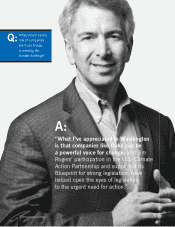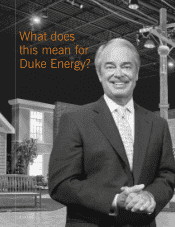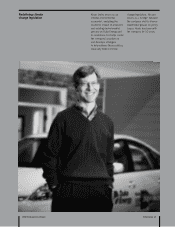Duke Energy 2008 Annual Report Download - page 26
Download and view the complete annual report
Please find page 26 of the 2008 Duke Energy annual report below. You can navigate through the pages in the report by either clicking on the pages listed below, or by using the keyword search tool below to find specific information within the annual report.
24 Duke Energy
Kevin Leahy
Managing Director,
Climate Policy
Cincinnati, Ohio
▲
Climate Legislation Focus
The challenge we faced when we first thought
about how to address climate change centered
on the fact that we emit a lot of carbon dioxide
(CO2). This happens when fossil fuels are
burned to produce electricity. Sure, we have
nuclear and hydroelectric plants, but we also
have a lot of plants that use coal, the most
CO2-intense fuel. We were concerned about
how this would impact our region and our
customers. Unlike many businesses, we can’t
simply close our operations and relocate to a
lower-cost country.
We need the right federal climate legislation,
and we’re working to make that happen. The
centerpiece has to be cap-and-trade, with
provisions for a fair transition for those regions
that rely on local fuels, such as coal.
We’re proud of our progress in this area,
but we’ve had help. We’ve been working
with many stakeholders, including the U.S.
Climate Action Partnership, a coalition of busi-
nesses (including our customers) and environ-
mental groups who don’t see business as the
enemy. Working together, we’ve developed a
pragmatic set of policies — a legislative blue-
print for action — designed to protect the envi-
ronment, keep energy prices affordable and
keep the communities we serve healthy and
prosperous. Learn more at www.us-cap.org.
We are also working to manage climate change
risks. But to do so, the United States should
set a goal to lower its greenhouse gas emis-
sions by 80 percent by 2050. It’s possible,
and while it won’t be cheap or easy, it can
still be affordable.
Electric utilities can reduce their CO2 emissions
to near zero by 2050. But to do that, we must
replace nearly all coal-fueled power plants with
new technologies. Because our economy is so
large, we’ll need to use all possible options —
renewables, low-emitting coal, nuclear, natural
gas and energy efficiency.
To keep the program affordable, we need
to more fully develop technologies that will
capture the CO2 from coal and inject it deep
underground in the same sorts of formations
that have held oil and natural gas for millions
of years — a process called “carbon capture
and sequestration” or CCS. Some of the
underlying technologies are ready now, but
some need more federal support. We hope
to use CCS at the integrated gasification
combined cycle power plant we are building
in southwestern Indiana.
As we decarbonize electricity, we can also
use it to power our vehicles. Not all of this is
ready right now, but it is doable and people
are working to make it happen.
What about the cost? We are concerned about
that as well, especially given the current state
of the global economy. Capping greenhouse
gas emissions must not drive up the price of
electricity so much that it harms our customers
and investors. That’s why we’ve made it our
business to understand the many policy
options and their impact on the economy
and our customers.
We believe that the right path is a market-
based cap-and-trade approach that protects
customers from rate shock by giving the value
of emissions allowances to customers. The
local distribution company, perhaps better
known as your local power company, is the
most effective and efficient vehicle for deliv-
ering this allowance value to customers. Done
right, climate change legislation won’t harm
our economy. Done wrong, such as a cap-and-
trade system with a 100 percent auction of
emissions allowances, customers will unnec-
essarily see dramatic increases in their bills.
Putting a price on carbon will increase energy
prices, and we are concerned about the impact
that will have on the average household and
small business, not to mention our larger
customers. Our focus is on how to minimize
the increases and make them happen slowly
over time. We are also advancing plans, such
as our save-a-watt program (see page 22),
to help our customers use less energy so
as prices increase, the hit on their bank
accounts will be less.
























